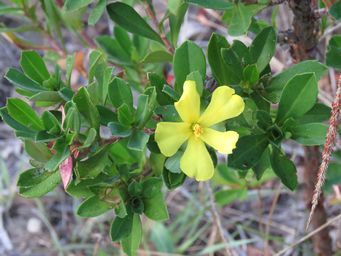Australia So Much to See
Copyright (C) 2013 AustraliaSoMuchtoSee.com. All reights reserved
Sources used for identification of wildflowers shown on these pages and regions where they occur see Credits
These pages will
feature some of the wildflowers we have photographed in Western Australia, and where possible, identified. If you
are able to help identify further flowers, or correct any I may have wrong, please contact us.
Information given for each species
will give botanical name, known common names, describe the flower, give time of year it flowered, and where it was photographed, and
the areas it occurs in. Names have been matched to Florabase which has also been used to show distribution.
See some
of these wildflowers in larger sized photos on our Flickr pages.
Hibbertia - but which ones out of over a 100 species? Primrose, Buttercup, Guinea Flower, Snake Vine, Climbing Guinea Flower
or Golden Guinea Vine
Yellow, five petals semi split, along stem. Size of flowers and leaf shape varies with different species
Late
Winter, Spring
Hibbertia species can be seen throughout the South West, Great Southern and Wheatbelt, the Mid West and into the
Goldfields, some in the Pilbara, and in the Kimberley regions.
Image above right seen at Lancelin in the coastal
Wheatbelt north of Perth. Flowers and foliage were similar to Hibbertia gracilipes, but it is not found in this region
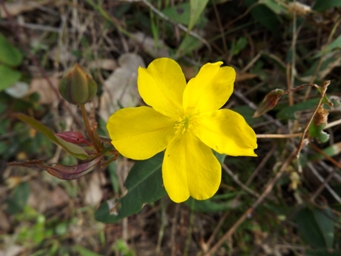
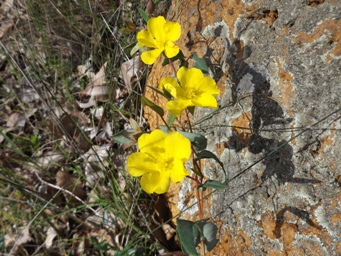
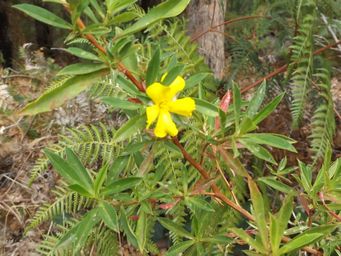
Hibbertia cuneiformis (above), Cutleaf Hibbertia
Yellow, five petals semi split, along stem. Larger than most Hibbertia species,
with clusters of elongated pointed leaves with two lesser points near the tip. Some leaves can turn red.
January to March
Albany
(above left) and Karridale (above right), and found in coastal areas extending from Perth to Esperance
Hibbertia amplexicaulis (above four photos)
Yellow, five petals semi split, growing along stem. This species has larger flowers
than other species being around four to five centimetres across. Leaves are oval or triangular and leaf base is wrap around
the stem (amplexicual), and may be straight edged or slightly wavy.
Spring
Bridgetown, South West Region, Western Australia and
grows within a wide strip from the coast in the lower Great Southern Region, South West and Perth regions.
At
right, the sepals after the petals have dropped on Hibbertia are often mistaken for a flower.
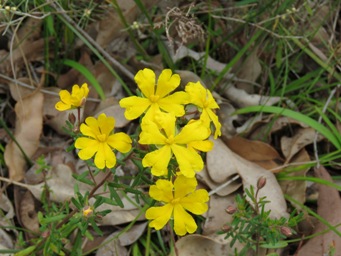
Hibbertia hypericoides, Yellow Buttercups
Yellow, five petals semi split, along stem, with stamens all turned in the same direction.
Flowers up to 2.5 centimetres across and leaves 0.5 centimetres long.
A low growing shrub with elongated leaves which are slightly
stippled in texture and terminate slight point. Some hairiness of edges of leaves and on stems.
Spring,
mainly seen flowering from July to November, but with unseasonal rain it can flower in any other months.
Bridgetown, South West Region,
Western Australia and grows within a wide strip from the coast from north of Geraldton to Albany incorporating parts of the
Mid West, northern Wheatbelt, Perth, South West and Great Southern Regions.
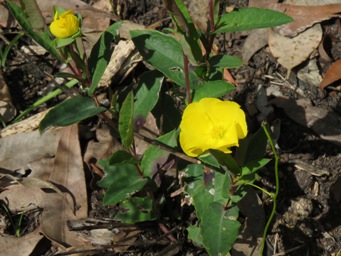
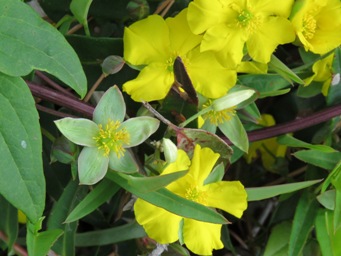
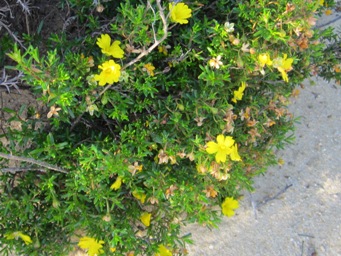
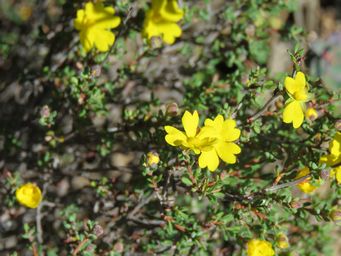
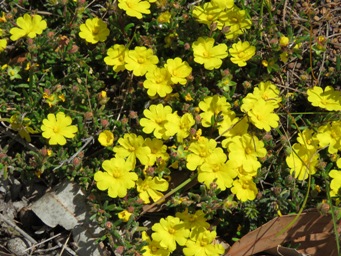
Hibbertia commutata
Yellow five petalled flowers of around 2.5 centimetres in diameter, with end of petal semi-split. Stamens
are in three groups. Hairy sepals as can be seen on buds, and some hairiness on these larger leaves.
August September
Bridgetown,
and common through the South West, Great Southern and Perth regions, and into adjacent areas of the Wheatbelt. Also recorded
from Ravensthorpe area.
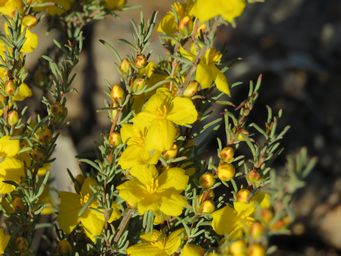
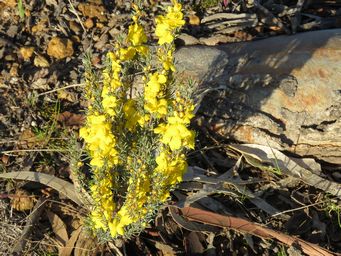
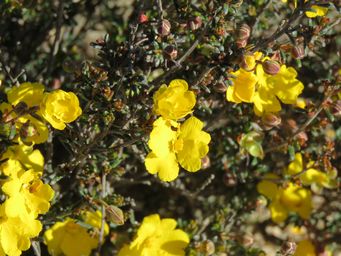
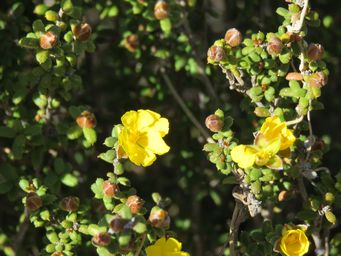
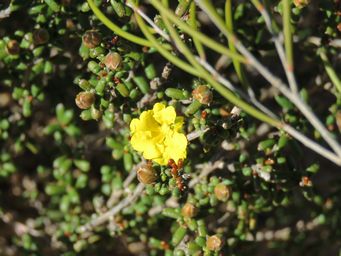
Hibbertia gracilipes
Yellow, five petals semi split, with stamens all turned in the one direction. Foliage appeared succulent with
a spike on each tip.
August
Photos above left were taken at different places along the Hyden-Norseman Road. The photo top
right at Tarin Rock Nature Reserve. Photo above right at Kulin.
The range is the southern Wheatbelt, Great Southern, and southernmost
parts of the Goldfields Region to and beyond Esperance
Hibbertia hemignosta
Yellow, five petals, on flowers along the stem in spikes (on this specimen), nine to twelve thick stamens arranged
in three groups. Narrow tubular leaves ending in a spine.
August
Kukerin in the Wheatbelt, Western Australia, and
occurs through the Wheatbelt, South West, Great Southern, and parts of the Goldfield Region to Esperance.
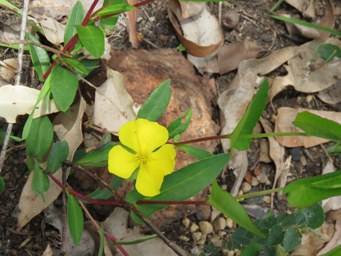
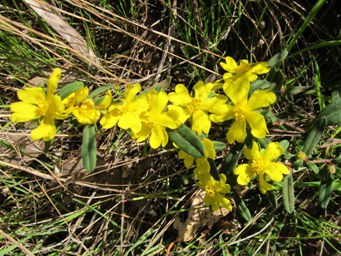
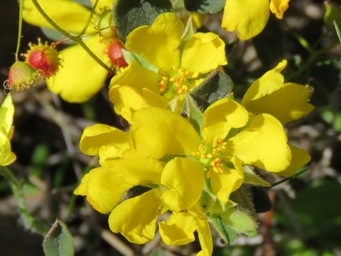
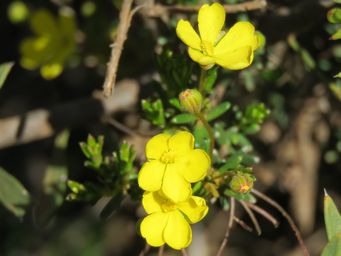
Hibbertia diamesogenos
A small yellow Hibbertia flowers of five semi-split petals, with stamens curved in one direction, on a bush
with elongated leaves which are slightly stippled in texture and terminate in a spine.
October
Tonebridge (Boyup Brook) and occurs
from north of Perth, through the South West and parts of the lower Great Southern regions, and further along the coastline near Esperance.
